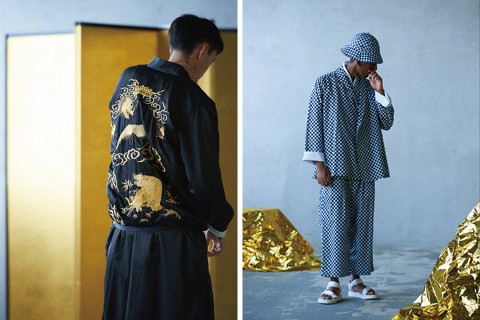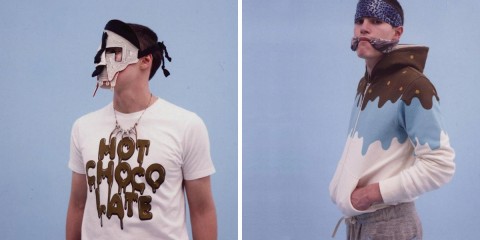Supreme’s latest collaborator, 13-year-old Japanese cult label Sasquatchfabrix, is informed by a similar approach to cultural sampling, artfully melding fashion with lifestyle, and a humorous sense of self-awareness.
The brand’s founder Daisuke Yokoyama studied architecture in art school, but found himself entranced with the practice of graphic design, so he started to focus on that. In 2003, he began publishing a zine about the bustling independent Japanese fringe art scene. To accompany it, he created a series of T-shirts, cementing the foundations of what would become Sasquatchfabrix. At its start, the project was part of an art collective called Wonder Worker Guerilla Brand (WWGB), which included designer Katsuki Araki.
As WWGB, the collective participated in multiple projects outside of Sasquatchfabrix’s purview, like a 2009 collaboration with Uniqlo’s graphic-heavy UT brand, which featured a hot chocolate-themed set of tees and hoodies. In 2011, Araki departed Tokyo in the aftermath of 2011’s Tohoku earthquake and tsunami, rendering WWGB dormant for all intents and purposes.
In an interview with Canadian store HAVEN, Yokoyama says he chose the name Sasquatch because it describes a UMA—an “unidentified mysterious animal.” The “fabrix” part of the name is pretty self-explanatory. With Sasquatchfabrix, he hopes to achieve the same mysterious, undefinable appeal of similar street-infused brands that can’t quite be classified, and occupy a unique space beyond the taxonomies of high fashion and streetwear.
“In the present day fashion scene, we wish to be like an UMA,” he tells HAVEN.
Indeed, Yokoyama’s inspiration stems heavily from the post-WWII cultural revolution in Japan. As documented in W. David Marx’s recently-published Ametora: How Japan Saved American Style, the country has played an integral part in preserving the West’s fashion culture. Sasquatchfabrix’s apothegm is two fold: “Sense of freshness” and “High-performance vandalism.” For Yokoyama, that means deft mashups of traditional Japanese garments and American subcultural style tribes.

Take for example, items like collarless cotton shirts that resemble Japanese noragis or the Hanten jacket, a nylon coaches jacket silhouette that’s been reinterpreted with traditional block prints—and in Sasquatchfabrix’s upcoming Supreme collaboration, retooled in the style of a tie-front noragi. Sportswear nerds found a grail item in the “Rival” pieces, a series of cut-and-sew tees and sweatshirts that featured asymmetrically-sewn halves that divided the logos for the Chicago Bulls and LA Lakers.
“Everything has accumulated layers of history, and remains are left at various places in the present day,” Yokoyama tells HAVEN. “We have a philosophy that the remainders can be dug up from such layers, evolved and brought back into existence to the present day.”

There’s a certain cheekiness in the way Yokoyama samples culture and renders it into clothing. For Beams’ 40th anniversary, he collaborated with the storied Japanese retailer on a louche collection dubbed “Oriental Skate.” Previous pieces include cotton twill fatigue pants with contrast panels meant to evoke the “peace” symbol, or his “Sunday Morning” graphic tee series, which began with a DIY concept. His approach to the tees was simple: “What if these were printed on a Saturday, and ready to wear on Sunday?” He mines plenty of Western references like Beavis & Butthead, and even flipped the classic Tommy Boy Records logo on its head, resulting in a tee that implies the silhouettes on the front are engaged in a traditional Japanese dance.
“My generation has a ‘mixed culture’ without a genre,” says Yokoyama. “I am conscious of showcasing ‘tradition’ at the right time. Then I add humor to it when creating things. I feel that’s the modern technique of designing.”
Despite being 13-years-old, Sasquatchfabrix remains a relatively obscure brand to the fashion masses. Similar to the mythical creature it’s named after, one might see sightings of it if you’re willing to put in the legwork. It only has nine overseas stockists, although MR PORTER recently picked it up, as it hones in on Japanese designers. However, the pieces the e-commerce platform carries are limited to Sasquatchfabrix’s BEAMS collaboration. For people looking for the collection proper, stockists like SSENSE, END., Goodhood and HAVEN offer respective edits of the label’s offerings.

As far as the brand’s Supreme collection is concerned, it serves as a great introduction to the ideas, values, personality and creative process behind Sasquatchfabrix, but Yokoyama’s best pieces supersede anything in the collaboration. Hokusai-esque Ecchi graphics, koi fish tees, and box-logo-adorned fans may appeal to fans of the novelty, but at best, it will put the deserving brand on the radar of more discerning consumers. The type of guy who becomes entranced by Yokoyama’s more cerebral pieces, like the forward-thinking trench coats and beautiful embroidered souvenir jackets from his Spring/Summer 2016 “Oriental Trail” collection.

The clothes from SS16 recall a variety of influences, from the historical significance of the Silk Road trade route to classic mod rocker motifs like checkerboard print, off-the-mountain hiking chic, and ‘70s tie-dye. It’s all over the place, totally unclassifiable, and yet looks and feels like a post-modern collection. Perhaps that’s exactly Yokoyama’s intent.
“Fashion exists with time and it changes,” says Yokoyama. “I have a belief that fashion itself should be an expression of time.”
For more from this niche label, be sure to check out Supreme’s forthcoming collaboration with Sasquatchfabrix, and for more Japanese cultural oddities, check out our interview with the country’s resident New Balance experts.

